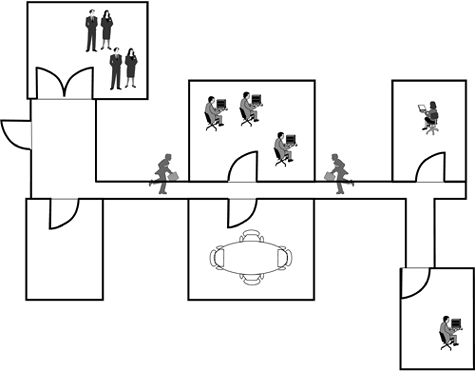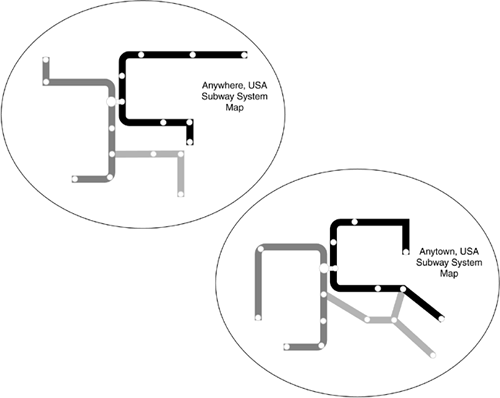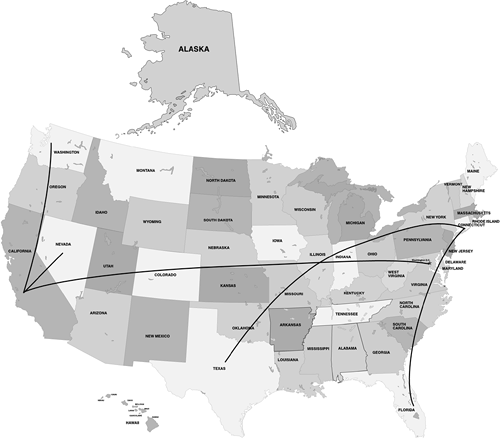Types of Networks
Three primary types of information networks are in use today:
Local-area networks (LANs) are found in small geographic areas, such as the floor of an office building.
Metropolitan-area networks (MANs) are found in medium-sized geographic areas, such one or several city blocks.
Wide-area networks (WANs) are found in large geographic areas, such as expanses that cross a state or country.
Figure 1-10 illustrates the concept of a LAN covering a small geographic area (in this case, the floor of an office building). For these employees to walk between rooms, they must use one or more of the hallways in the building. In this case, the network of hallways provides the connection between each room, enabling each person to move locally on the floor of this building. You would be hard pressed to find a hallway that stretches across several city blocks (MANs) or several states (WANs).
Figure 1-10. Office Building Floor

The following characteristics differentiate one network from another:
Topology? The physical or logical geometric arrangement of devices on the network. For example, devices, such as computers, routers, or switches, can be arranged in a ring (Token Ring and Fiber Distributed Data Interface [FDDI]) or in a straight line (Ethernet).
note

Token Ring, FDDI, and Ethernet are all LAN technologies with respective topologies and are discussed in more detail in Chapter 4, "Traditional LAN Architecture."
Protocols? The rules and specifications for communication between two devices, similar to grammar in a spoken or written language. For two people to be able to understand each other, for instance, they must both use not only the same language, but also the same syntax and grammar. Network protocols use these same rules of syntax and grammar to determine the following: how the devices talk with each other; whether the network is a peer-to-peer network, such as for file sharing; whether the network has a client/server architecture, such as used with a corporate database for inventory lookup in a retail store or warehouse.
Media? The physical media carrying the signal between the two network points (source and destination). Examples of media include twisted-pair wire (shielded or unshielded), coaxial cables, fiber-optic cables connecting network devices, and the air. Some networks, such as wireless LANs (WLANs) and radio use the air as their communication media.
note
LAN topologies, protocols, and media are discussed in Chapter 4. |
LANs
A local-area network (LAN) is a computer network spanning a small geographic area, such as a single building or floor within a building. One LAN can be connected to other LANs over any distance through media, such as telephone lines or radio waves. A system of LANs connected in this fashion is called a wide-area network (WAN).
There are many different types of LANs, and Ethernet is the most common LAN type used today. Some other common LAN types include Token Ring and FDDI.
note
Ethernet, Token Ring, and FDDI are discussed in more detail in Chapter 4. |
Most LANs connect workstations, personal computers, and network printers to each other, often for the purpose of resource sharing. Each individual device on a LAN is called a node. Most LAN workstations have their own central processing unit (CPU) with which they execute programs, such as a spreadsheet or word processor program. LAN workstations are also capable of accessing data and devices anywhere on the same LAN. This means that many users can share devices, such as printers, as well as data, either through direct file sharing, or through another LAN node called a file server. Users can also use the LAN to communicate with each other, by sending e-mail or engaging in chat sessions, such as those provided by instant messenger applications.
note
A file server is a central repository for file storage. Instead of several people in an office e-mailing the same file to each other, for example, the file can be kept in a central location and each person can access the file directly to read or write updates. A print server is a computer that manages print requests from multiple users and provides printer status information that is available to end users and network administrators. |
MANs
A metropolitan-area network (MAN) is a data network designed for a town or city. A MAN can either be built as service provider and leased among multiple customers or a company can build its own private MAN. In terms of geographic breadth, MANs are larger than LANs, but smaller than WANs. MANs are usually characterized by high-speed connections using fiber-optic cable or other digital media and are often used by companies with several offices located within the same city. A corporation can extend the LAN services in each building across a metropolitan region by deploying a MAN to interconnect each corporate office.
An example of a noncomputer MAN in today's world is a city subway system. The subway routes interconnect different points within a metropolitan area, such as a city, as illustrated in Figure 1-11.
Figure 1-11. Subway System Map for Anywhere, USA

WANs
A wide-area network, or WAN, is a computer network that spans a relatively large geographic area, such as an expanse that crosses several states or countries. Computers connected to a WAN are often connected through public networks, such as the telephone system (through a network service provider). Computers can also be connected through leased lines or satellites, also from a network service provider.
note
The largest WAN in existence is the Internet. |
An example of a noncomputer WAN in today's world is the routes flown by various airlines between cities. These routes span a broad geographic area. Figure 1-12 shows an airline route map; in this case, the geographic area is North America.
Figure 1-12. Airline Route Map







